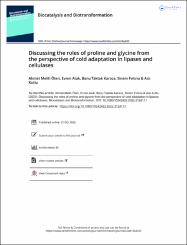| dc.contributor.author | Öten, Ahmet Melih | |
| dc.contributor.author | Atak, Evren | |
| dc.contributor.author | Karaca, Banu Taktak | |
| dc.contributor.author | Fırtına, Sinem | |
| dc.contributor.author | Kutlu, Aslı | |
| dc.date.accessioned | 2023-01-09T07:12:53Z | |
| dc.date.available | 2023-01-09T07:12:53Z | |
| dc.date.issued | 2022 | en_US |
| dc.identifier.citation | Öten, A.M., Atak, E., Karaca, B.T., Fırtına S., Kutlu A., (2022). Discussing the roles of proline and glycine from the perspective of cold adaptation in lipases and cellulases, Taylor and Francis Group, Biocatalysis and Biotransformation pp. 1-18. https://doi.org/10.1080/10242422.2022.2124111 | en_US |
| dc.identifier.issn | 1024-2422 | |
| dc.identifier.issn | 1029-2446 | |
| dc.identifier.uri | https://hdl.handle.net/20.500.12900/138 | |
| dc.description.abstract | Lipases and cellulases have been extensively used in the field of biotechnology for varied purposes. Mainly, the ongoing researches focus on the improvements of kinetic and enzymatic characteristics of enzymes to meet industrial needs. With the discovery of psychrophilic cellulase and lipase sources, a new era has opened for protein research by allowing the discovery of novel functions together with the description of unique cold adaptation mechanisms to harsh environments. The ability of cold-adapted lipase and cellulases to enable chemical reactions at lower temperatures provides a great opportunity to cut the cost of the finished product by lowering energy and purifying expanses. The advances in the cold-adapted lipase and cellulase enzymes are the cumulative efforts of organic chemists, biophysicists, biotechnologists, and process engineers who greatly contribute to a better understanding of cold-adaptation phenomena from different points of view. In this review, we cover the cold-adaptation aspects of cellulase and lipase enzymes from structural points of view by referring to the roles of Gly and Pro residues. Gly and Pro residues accelerate the cold-adaptation of enzymes by altering the conformational changes in the 3 D structure of proteins The list of microorganisms as a source of cold-adapted cellulases and lipases is given by referring to biotechnological applications. After introducing the thermodynamic background of Gly and Pro residues in the phenomena of cold-adaptation, specific examples are given to emphasise how introducing Gly and Pro into 3 D structure of protein molecules adds value in terms of biotechnological application by contributing to cold-adaptation. | en_US |
| dc.language.iso | eng | en_US |
| dc.publisher | Taylor and Francis Group | en_US |
| dc.relation.isversionof | 10.1080/10242422.2022.2124111 | en_US |
| dc.rights | info:eu-repo/semantics/openAccess | en_US |
| dc.subject | Cold-adaptation | en_US |
| dc.subject | Glycine | en_US |
| dc.subject | Proline | en_US |
| dc.subject | Cellulase | en_US |
| dc.subject | Lipase | en_US |
| dc.title | Discussing the roles of proline and glycine from the perspective of cold adaptation in lipases and cellulases | en_US |
| dc.type | article | en_US |
| dc.department | İstanbul Atlas Üniversitesi, Mühendislik ve Doğa Bilimleri Fakültesi, Moleküler Biyoloji ve Generik Bölümü | en_US |
| dc.authorid | Banu Taktak Karaca / 0000-0002-9657-4679 | en_US |
| dc.contributor.institutionauthor | Taktak-Karaca, Banu | |
| dc.identifier.startpage | 1 | en_US |
| dc.identifier.endpage | 18 | en_US |
| dc.relation.journal | Biocatalysis and Biotransformation | en_US |
| dc.relation.publicationcategory | Makale - Uluslararası Hakemli Dergi - Kurum Öğretim Elemanı | en_US |

















